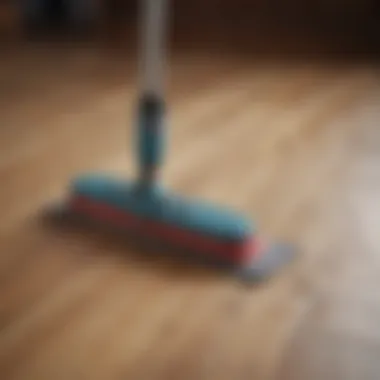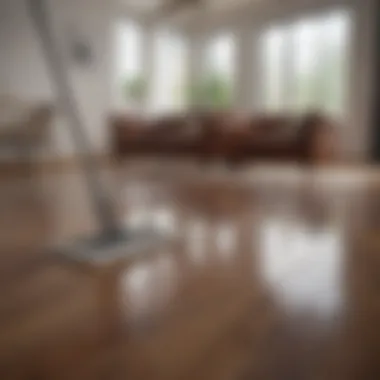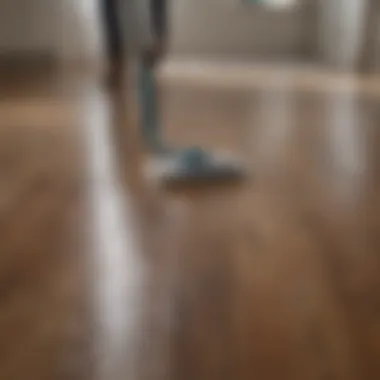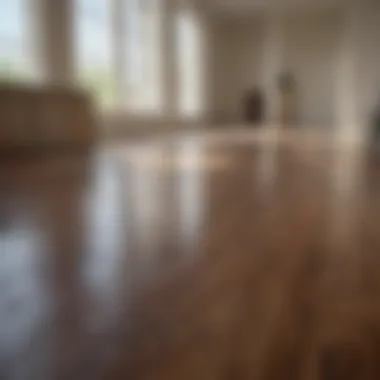Effective Cleaning Techniques for Laminate Floors


Intro
Cleaning laminate floors might seem like a straightforward task, but it requires a bit of finesse and understanding to get it right. The right techniques can extend the life of your floors while keeping them looking sharp. Homeowners often wrestle with the mystery of maintaining these surfaces, balancing between effective cleaning and avoiding damage. That’s where knowing the optimal methods comes in.
This guide will navigate you through the essentials of caring for laminate flooring. From choosing suitable cleaning tools to avoiding common pitfalls, we will explore the nuances of this often underrated home maintenance task. The aim is not just to inform but to empower, so your laminate floors can last longer and maintain their beautiful appearance for years to come.
Prologue to Laminate Flooring Maintenance
When it comes to maintaining laminate flooring, understanding the fundamental aspects of its upkeep can significantly enhance the look and longevity of your floors. Laminate flooring, while known for its durability and aesthetic appeal, requires careful handling. Proper cleaning techniques are not merely a matter of keeping floors tidy; they can prevent deeper issues, such as scratches and water damage, that are sometimes all too easy to overlook.
In this section, we’ll dive into the nuances of laminate materials and the importance of applying the right cleaning methods. Homeowners often find themselves at a crossroads, unsure about what products or practices will both preserve their flooring investment and maintain its beauty. To truly appreciate laminate flooring, it's essential to grasp the materials it's made from and how these can influence cleaning choices.
Additionally, we'll explore the need for proper techniques when it comes to cleaning. Using inadequate tools or methods can lead to irreversible damage, which is why the right knowledge is vital. Understanding these elements will not only save you money in the long run but also ensure your floors sparkle as they should.
Understanding Laminate Materials
Laminate flooring is a layered product, consisting of a core made from high-density fiberboard (HDF), which combines durability with a lower cost alternative to hardwood. On the surface, there's a decorative layer that mimics wood grain or even stone patterns. This is followed by a protective layer that guards against everyday wear and tear.
Knowing these layers is crucial. The top layer's strength varies depending on the manufacturer, making some laminates more resistant to scratches and stains than others. When cleaning, it’s essential to avoid harsh chemicals that may strip away this protective coating, ultimately leading to faded or dull surfaces.
Importance of Proper Cleaning Techniques
Cleaning laminate floors isn’t just a chore; it's an art. Inadequate cleaning can quickly turn into a nightmare, as it may lead to irreversible damage like warping or peeling. When you use too much water or inappropriate cleaners, you're risking your laminate's integrity.
A common myth is that laminate flooring can withstand wet mopping like tiles or real wood; however, the truth is that excess moisture seeps into the seams, causing the boards to swell and become unsightly. Thus, understanding the right product to use, along with techniques such as damp mopping and using specific cleaning solutions, is imperative.
"Proper techniques not only clean but also help preserve laminate floors, elongating their lifespan. Paying attention to materials and methods is key to successful maintenance."
Preparing for the Mopping Process
Getting ready to mop laminate floors requires thoughtful preparation. Before you even get that mop out, there’s some groundwork to lay down. Knowing what you need and assessing the state of your floors is half the battle. This section dives into these essential preparatory steps, underscoring the impact they have on the overall cleaning results.
Gathering Essential Tools and Equipment
Types of mops suitable for laminate floors
The choice of mop can make or break the cleaning process. When it comes to laminate, microfiber mops are often the star of the show. They're gentle enough not to scratch the surface, yet effective in lifting dirt and grime. Say goodbye to traditional cotton mops; while they may work well on other surfaces, the excessive moisture they can leave behind is a nightmare for laminate.
Microfiber mops stand out for their ability to trap dust and absorb liquid, making them an ideal companion for caring for laminate floors. It's like having a little army of fibers that are ready to tackle whatever mess you throw at them. Additionally, many microfiber mops can be used dry for dusting before you even think about adding moisture. However, the unique texture of these mops means they must be washed properly after use to avoid any build-up of residues or bacteria.
Recommended cleaning solutions


Not all cleaning solutions play nice with laminate. It’s essential to select products that are specifically designed for laminate flooring; otherwise, you might risk damaging your floors. Generally, a good pH neutral cleanser will do the trick. Look for products labeled for laminate use and avoid harsh chemicals that could lead to discoloration or dullness.
Additionally, some DIY solutions can also shine in this category. A simple mixture of vinegar and water in the right ratios can effectively clean without leaving harmful residues behind. Just remember, while vinegar may be effective, it must be diluted properly to maintain the integrity of your floors.
Assessing Floor Conditions
Identifying stains and dirt types
Before you start mopping, it's wise to take a good look at the condition of your floors. Not all stains are created equal, and knowing what you're dealing with can save considerable time and effort. For instance, oil stains require a different approach compared to those pesky pet accidents. Identify the type of stain is crucial because different strategies will be needed for a successful clean.
Being aware of floor condition can save frustration later. Spot-cleaning stubborn stains before going into full mop mode can be a game changer. If you find food spills or sticky residue, focusing on those first can lead to a more satisfying final result.
Determining maintenance frequency
The frequency of cleaning is another cornerstone of floor maintenance. Think about how much traffic your floors endure. High traffic areas can pick up dirt and debris at a frightening speed. Establishing a routine will greatly affect the time and effort required for cleaning.
For instance, if you have kids or pets running around, a more frequent cleaning schedule may be necessary. You might also want to do a thorough mop at least once a week, but this may vary by household. By determining the right cleaning frequency, you can avoid long-term buildup and subsequent damage, extending the life of your laminate floors considerably.
A good rule of thumb is to adjust your maintenance routine based on the activity level in your home. Keeping an eye on the overall state of your floors will help you find the sweet spot of cleaning frequency.
Best Practices for Mopping Laminate Floors
When it comes to keeping laminate floors looking their best, understanding the best practices for mopping is paramount. Effective mopping not only cleans surfaces but also preserves the integrity and shine of the flooring. This article highlights the significance of using the right methods and materials to prevent potential damage while maintaining aesthetic appeal. Following these practices can lead to an extended lifespan for your floors, which is a wise investment for any homeowner.
Step-by-step Mopping Guide
Pre-cleaning assessments
Pre-cleaning assessments form a crucial part of the mopping process. Before hitting the floor with your mop, taking a moment to evaluate the surface can be incredibly beneficial. Look for visible spots, sticky residues, or any debris that might need special attention. The key characteristic here is observation. By identifying heavily soiled areas beforehand, you can tailor your cleaning approach effectively.
This proactive approach allows for targeted cleaning, ensuring that no spot is left untouched. One unique feature of pre-cleaning assessments is that they prevent the unnecessary use of water on more delicate areas, which is a typical blunder in floor care. Ignoring this step can result in a less effective cleaning experience and even long-term damage to your laminate floors.
Technique for effective mopping
The technique for effective mopping involves a blend of strategy and skill. Using a mop specially designed for laminate—typically a microfiber variant—ensures that cleaning is gentle yet thorough. A key characteristic of this technique is the zigzag motion, allowing for maximum surface coverage while avoiding puddles of excess water, which can warp laminate over time.
Furthermore, starting from the farthest corner of the room and moving toward the door is a commonly adopted approach. This method minimizes the risk of stepping on wet sections, which can be both inconvenient and potentially hazardous. One advantage of this mopping technique is that it optimizes floor coverage, ensuring every inch gets the attention it deserves. However, not paying attention to pressure during mopping could result in streaking, and therefore, a soft touch is necessary.
Frequency of Cleaning
Daily vs. weekly cleaning schedules
Establishing a cleaning schedule is essential for sustaining the luster of laminate floors. Daily cleaning might be excessive for some households, especially those without high foot traffic. However, taking 5-10 minutes daily to sweep or lightly mop can help maintain cleanliness and prevent a build-up of dirt and grime. On the other hand, a weekly deep clean should also be part of routine maintenance for households that see more action.


The primary distinction lies in the commitment to daily upkeep versus the thoroughness of weekly cleans. Daily touch-ups can prevent that dreaded build-up of dirt while managing wear and tear on the laminate itself. The unique feature of this approach is that it promotes a consistent habit, making maintenance become second nature. However, overdoing it daily could diminish the floors’ gloss if too harsh products are used, which is another reason to find the right balance.
Seasonal deep cleaning recommendations
Seasonal deep cleaning recommendations add yet another layer to laminate floor care. This is not a one-size-fits-all situation; identifying the right moments for a thorough clean can depend on the climatic conditions of your region. As seasons change, the types of dirt, debris, or moisture entering your home may also shift. Therefore, a seasonal checklist could serve well here.
During spring and fall, doing a comprehensive cleaning can significantly uplift the floor's appearance. This practice involves not just mopping, but also vacuuming, polishing, and even applying a laminate-friendly conditioner. The unique feature of seasonal cleaning is that it aligns execution with natural environmental shifts, keeping floors in top form. However, neglecting this aspect during harsh winters or rainy seasons could allow dirt and moisture to linger, leading to potential damage down the road.
Keeping laminate floors clean isn’t just about aesthetics; it’s about preserving your investment and ensuring your living space remains welcoming.
By employing these best practices in mopping laminate floors, you will maximize your efforts towards maintaining the beauty and longevity of your flooring. Taking the time to assess, adopt effective techniques, and schedule cleanings wisely is fundamental to achieving ideal results.
Common Mistakes in Laminate Floor Care
When it comes to keeping laminate floors looking their best, it’s all too easy to stumble into a few common pitfalls. Awareness of these mistakes can make all the difference in maintaining the pristine appearance of your surfaces. By avoiding these missteps, homeowners not only prolong the life of their floors but also enhance their overall living environment.
Avoiding Excessive Water Use
One fundamental error that many people make when cleaning their laminate floors is using too much water. Laminate is sensitive to moisture; too much liquid can seep between the boards, leading to warping and swelling. The key here is to use a slightly damp mop rather than soaking wet. A common belief is that a flooded floor means a thorough clean, but that couldn’t be further from the truth.
Effective Methods for Minimizing Water Use:
- Microfiber Mops: These are excellent for laminate flooring as they require minimal water. They’re designed to trap dust and dirt effectively without needing to be doused in water.
- Spray Mops: With a built-in spray mechanism, these mops allow you to apply a controlled amount of cleaning solution directly onto the floor, ensuring it's never too wet.
Neglecting Regular Maintenance
Another key mistake is neglecting maintenance schedules. It’s easy to forget about upkeep when things appear clean, but laminate floors require attention at regular intervals. For many, it’s out of sight, out of mind, but this can lead to bigger issues down the line.
Consequences of Skipping Maintenance:
- Stains and Scuffs Build Up: A lack of regular cleaning allows dirt and stains to set in, making future cleaning more difficult.
- Increased Wear and Tear: A solid maintenance routine helps prevent scratches and dull spots from building up, extending the floor's longevity.
To avoid these challenges, establish a cleaning routine based on the foot traffic in your home. For instance, homes with pets or children may require more frequent attention. Aim to clean high-traffic areas weekly, while less busy spots can be done bi-weekly or monthly.
"An ounce of prevention is worth a pound of cure."
Regular maintenance not only keeps your laminate floors looking sharp but also saves time and effort in the long run.
By addressing these common mistakes, homeowners can keep their laminate floors in tip-top shape, ensuring they remain a stunning feature of their homes.
Long-term Care for Laminate Floors
Taking good care of laminate floors goes beyond quick clean-ups and routine mopping. Long-term care is essential for maintaining the appearance and extending the lifespan of these surfaces. By taking proactive measures, homeowners can avoid costly repairs and replacements. This section will delve into preventive strategies and available refinishing options, keeping the floors looking their best for years to come.


Preventive Measures
Preventive care is the backbone of long-term laminate floor maintenance. Small steps can lead to big improvements. Implementing effective protective measures can significantly reduce wear and tear, minimizing the need for frequent cleanings or repairs later down the line.
Using mats and runners
Placing mats and runners around areas with high foot traffic is a practical way to protect laminate floors. Mats catch dirt and debris before it makes its way onto the flooring. This stops those stubborn scratches and stains from forming. The key benefit here is simple: it’s easier to clean a mat than to repair wear on the floor itself.
Another positive aspect is that many mats now come in various designs and colors to match the interior decor. This means functionality does not have to sacrifice style. It creates a win-win situation for homeowners who want protection without compromising aesthetics. However, be cautious with mats that have rubber backing, as they may trap moisture and lead to warping.
Managing humidity levels
Humidity control is another vital element in the long-term care of laminate floors. Laminate is sensitive to changes in moisture. Extremely high humidity can make the flooring swell, while very low humidity might cause cracking. The right balance is key. Maintaining levels between 30% to 60% relative humidity is generally recommended.
Homeowners can manage humidity by using dehumidifiers or humidifiers when necessary. Air conditioning can also play a significant role in controlling indoor moisture levels. While these methods are beneficial for overall home comfort, they also help avoid long-term damage to laminate flooring. Keep in mind that excessive reliance on environmental control devices can lead to increased electricity bills.
Refinishing and Repair Options
Over time, even the best-maintained laminate floors will show signs of age and wear. Understanding when to refinish or repair the surface can save significant frustration and cost in the long run. Unlike traditional hardwood, laminate can't typically be sanded down, but there are still options available to restore their glory.
Signs of wear and tear
To keep laminate floors in tip-top shape, being able to identify signs of wear and tear is invaluable. Look for scratches, dullness, or discoloration. All these factors indicate that the flooring may need more than just regular maintenance. Recognizing these signs early is beneficial because it allows for timely intervention before the damage worsens.
Another important characteristic is how often these signs appear. For active households, it might be a regular occurrence. Regular checks on the flooring will help catch issues promptly. These simple scans can save homeowners from paying significantly later for replacements or extensive repairs.
Options for restoration
When it comes to restoring laminate flooring, options vary according to the severity of the wear. For minor scratches, surface repair kits can be useful. These usually come in many colors to match laminate finishes. For deeper issues, replacing individual planks might be necessary. It’s often a good idea to keep extra panels on hand from the original installation.
Replacement is often straightforward. Many laminate floors are modular, meaning homeowners can pop out the damaged sections and slot in a new piece. Always consider checking the manufacturer’s warranty or customer service for potential restoration methods. While restoration options are handy, they tend to be labor-intensive and may require a professional touch for best results.
Closure
Cleaning laminate floors is not just a chore; it's an essential part of maintaining the beauty and lifespan of your home’s interior. In this article, we emphasized that proper techniques impact both the appearance and durability of these surfaces. A clean laminate floor can make a room feel welcoming, while dirt and stains can diminish its charm. Hence, understanding the nuances of laminate care is paramount for all homeowners.
Summary of Key Points
In summarizing this discussion, several key points stand out:
- Understanding Materials: Knowing what laminate is made of helps in selecting appropriate cleaning methods.
- Preparation: Gathering the right tools and assessing the floor condition are crucial steps that should not be ignored.
- Mopping Techniques: Adhering to the right mopping practices will ensure effective cleaning without damage.
- Common Mistakes: Being aware of common pitfalls like using too much water can save you from costly repairs or replacements.
- Long-term Care: Taking preventive measures and knowing when to repair or refinish can keep your floors looking their best for years.
Final Thoughts on Laminate Floor Maintenance
Ultimately, maintaining laminate floors requires a blend of knowledge and effort. Engaging in good cleaning practices not only preserves the aesthetic value of your floors but also contributes to a healthier living environment. As real estate enthusiasts, travel lovers, or interior design aficionados, understanding these maintenance techniques sets you apart as a responsible homeowner.
"A well-maintained laminate floor can be the foundation of a beautiful space, enhancing both functionality and style."
Remember, the key to long-lasting laminate flooring lies in continuous care and attention to detail. Armed with the insights from this article, you're now better equipped to give your floors the attention they deserve.







